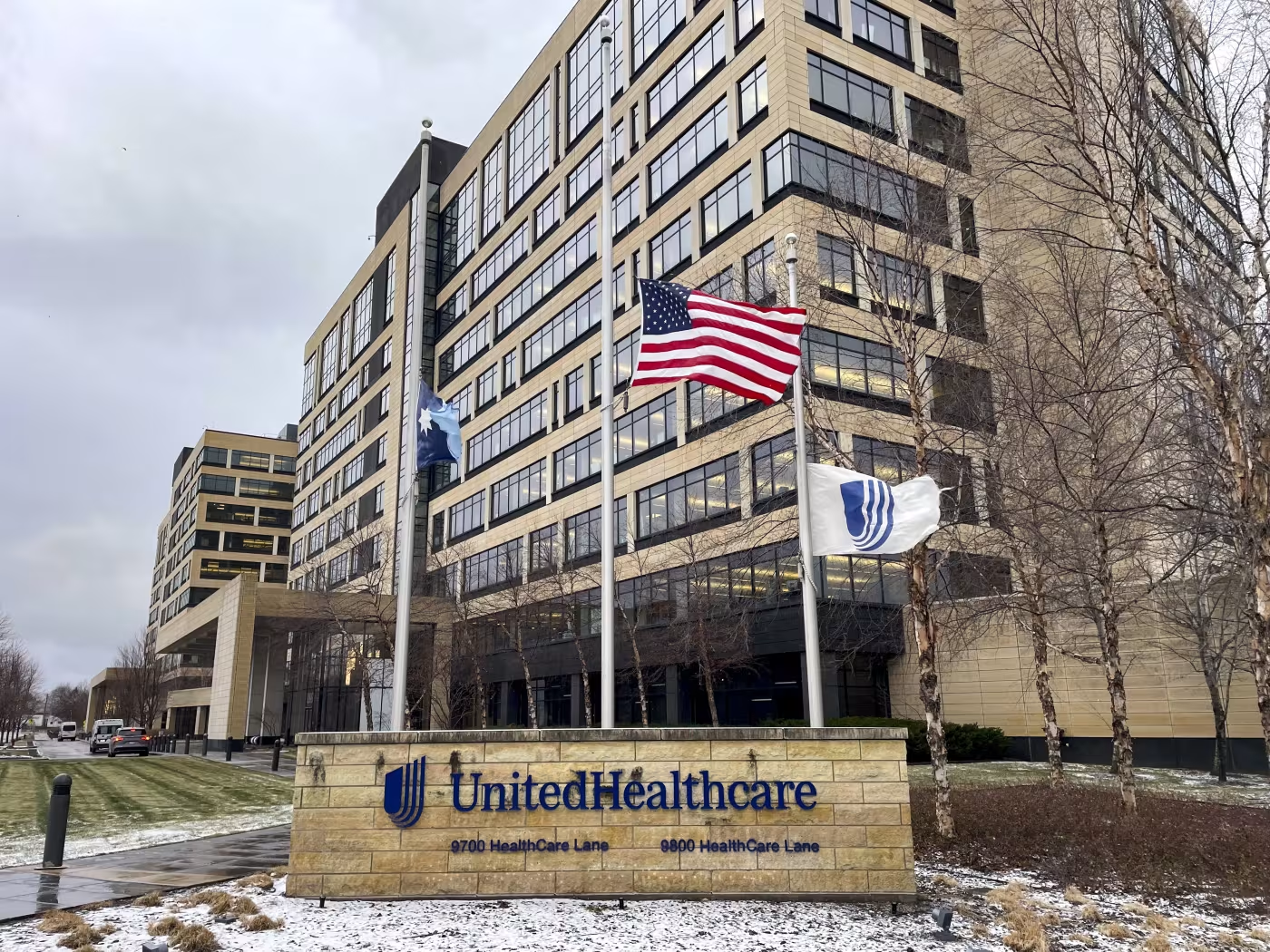Thursday Report

Healthcare Dive shares observations and news about yesterday’s murder of United Healthcare’s CEO Brian Thompson.
Yahoo News delves into the investigation of Mr. Thompson murder by the New York City Police Department. The FEHBlog has the utmost confidence that this investigation will end with at least one arrest.
From Washington, DC
- Federal News Network informs us,
- “Enrollees in the new Postal Service Health Benefits program will have a few extra days of Open Season to review their plan options and make changes to their benefits for plan year 2025.
- “The Office of Personnel Management officially extended Open Season for PSHB participants until Dec. 13, Federal News Network has learned. Participants in the Federal Employees Health Benefits program and other federal benefits programs will still see Open Season end on the original Dec. 9 deadline.
- “OPM said the transition to the new PSHB program is “a big change” for enrollees, and it’s extending Open Season by four days to give Postal employees, annuitants and their family members additional time to look at plans and make changes as they see fit.
- “We feel it is important to extend Open Season for customers of the PSHB program to give them ample time to shop for plans and change their elections if they want to,” OPM said.
- Tammy Flanagan, writing in Govexec, discusses Open Season and tax savings.
- Politico reports,
- “The House is losing several health policy leaders after this Congress, and they’ll likely want to make their mark in their last two months on Capitol Hill.
- “While Congress negotiates its end-of-year legislative package, some key departing lawmakers are rallying to pass projects before their terms end — although expectations for a health care package are low. Historically, Congress has sometimes shown a willingness to give outgoing lawmakers a win.”
- Politico shares the legacy goals of the retiring House members.
- Among the bills for possible inclusion in the lame duck health care package is S. 1339, Pharmacy Benefit Manager Reform Act. The Congressional Budget Office issued a report on this bill today.
- The Washington Post informs us,
- “A bipartisan group of senators grilled Food and Drug Administration officials Thursday on the agency’s failure to more tightly regulate ultra-processed foods and food dyes, highlighting a key part of the health agenda promoted by Robert F. Kennedy Jr.
- “Kennedy, President-elect Donald Trump’s controversial pick to lead the sprawling Department of Health and Human Services, which oversees the FDA, has blamed the nation’s surge of chronic disease and declining life expectancy on ultra-processed foods — a position that aligns with Sen. Bernie Sanders (I-Vermont), who convened the hearing as chairman of the Senate health committee.
- “Congress and the FDA have allowed large corporations to make huge profits by enticing children and adults to consume ultra-processed food and beverages loaded up with sugar, salt and saturated fat,” Sanders said Thursday, pointing to the billions of dollars the food-and-beverage industry spends on advertising.”
- Govexec notes,
- “The leaders of President-elect Trump’s new advisory panel aiming to slash government spending, Elon Musk and Vivek Ramaswamy, met with Republican lawmakers at the Capitol on Thursday in what leaders pitched as an informational session to share ideas.
- “Congressional Republicans and a handful of Democrats have embraced Trump’s Department of Government Efficiency, which will function as a non-governmental commission, and on Thursday were eager to share their ideas for identifying areas for cuts. Some Republicans cautioned, however, that the advisory panel must work through the appropriate channels and win congressional support for their initiatives.
- “Nearly every House and Senate member that emerged from the various meetings called them productive and suggested a unifying idea supported by both lawmakers and Trump’s designated efficiency czars: recalling teleworking employees back to the office.”
- Per Department of Health and Human Services press releases,
- “Today, the National Action Alliance for Patient and Workforce Safety (NAA) at the U.S. Department of Health and Human Services (HHS) launched the National Healthcare Safety Dashboard, an online resource that aggregates hospital safety data from four primary measurement sources. Thus, the dashboard creates one comprehensive resource for understanding the current state of patient and workforce safety.”
- and
- “Today, the U.S. Department of Health & Human Services (HHS), Office for Civil Rights (OCR), issued a “Dear Colleague” letter – PDF to help federally funded health care providers, plan grantees, and others better understand their civil rights obligations under the new final rule on Section 1557 of the Affordable Care Act (“Section 1557”).
- “Section 1557 provides nondiscrimination protections by requiring covered entities (e.g., recipients of Federal financial assistance, programs administered by HHS, and entities established under Title I of the Affordable Care Act (ACA)) to provide language assistance to individuals with limited English proficiency (LEP) or disability.”
- Modern Healthcare reports,
- “Hospitals have expanded their legal push for the federal government to boost Medicare reimbursement.
- “More than 500 hospitals last week sued the Health and Human Services Department for allegedly miscalculating a 40-year-old Inpatient Prospective Payment System base reimbursement rate that providers say has lowered years of subsequent Medicare payments to hospitals. The lawsuit is the latest in a series of similar complaints that allege the Health and Human Services Department must increase Medicare inpatient pay.
- “Each lawsuit challenges different batches of denied requests to amend reimbursement rates, but the arguments are largely the same. Hundreds of millions of dollars are at stake, providers allege. If the federal government changes the inpatient base pay rate, hospitals stand to not only recoup money from prior fiscal years but also increase future reimbursement rates.”
- The American Hospital Association News tells us,
- “A $2.8 billion settlement from Blue Cross Blue Shield to health care providers resolving a 12-year antitrust lawsuit received preliminary approval yesterday from the U.S. District Court for the Northern District of Alabama. The settlement will also “significantly improve how Providers will interact with the Blues, bringing more transparency and efficiency to their dealings, and increase Blue Plan accountability,” according to the court filing.
- “The lawsuit alleged that BCBS member companies violated antitrust laws by agreeing to allocate markets via exclusive service areas and fixing prices paid to health care providers through the organization’s BlueCard Program.”
- and
- “Approximately 988,000 consumers who currently do not have health insurance coverage through the individual marketplace have signed up for a 2025 health plan through the federally facilitated Health Insurance Marketplace, the Centers for Medicare & Medicaid Services announced yesterday. Nearly 4.4 million returning consumers have selected 2025 plans. The open enrollment period began Nov. 1 and continues through Jan. 15.”
- The deadline for January 1, 2025, enrollments is December 15, 2024. Later enrollments will begin on February 1, 2025.
- and
- “The Food and Drug Administration yesterday released recommendations for streamlining the approval process for medical devices that use artificial intelligence. The guidance recommends information to include in a predetermined change control plan as part of a marketing submission for a medical device using AI. The PCCP should include a description of the device’s planned modifications; methods to develop, validate and implement the modifications; and an assessment of the modification’s impacts. FDA will then review the PCCP within the submission to ensure the device’s safety and effectiveness without needing additional marketing submissions for each modification.”
From the public health and medical research front,
- The Washington Post reports,
- “Scientists from the Scripps Research Institute are reporting that it would take just a single mutation in the version of bird flu that has swept through U.S. dairy herds to produce a virus adept at latching on to human cells, a much simpler step than previously imagined.
- “To date, there have been no documented cases of one human passing avian influenza to another, the Scripps scientists wrote in their paper, which was published Thursday in the journal Science. The mutation they identified would allow the virus to attach to our cells by hitching itself to a protein on their surface, known as the receptor.
- “William Schaffner, a professor of infectious diseases at Vanderbilt University Medical Center who did not participate in the study, called the research “sobering,” adding, “I had not known it would take just one mutation in the virus for it to attach itself to the receptors on human cells.
- “However, he stressed that the H5N1 virus has been active for 20 years and “has multiplied billions upon billions upon billions of times and the spontaneous mutation that the authors describe,” has not been found, despite intense surveillance.
- “Yoshihiro Kawaoka, a professor of virology at the University of Wisconsin, who was not involved in the latest research but has studied bird flu extensively, said that statistically, the mutation probably already exists in H5N1-infected cows and humans, given that 1 in 10,000 infectious particles of the influenza virus is a mutant.
- “James C. Paulson, one of the paper’s authors, and several other top scientists agreed that it is statistically likely the mutation has occurred in the H5N1 virus but stressed that it has yet to be detected, and other barriers remain before the virus could be transmitted from one person to another. Paulson is a professor in the Department of Molecular Medicine at Scripps.”
- The National Institutes of Health Director, Dr. Monica Bertagnolli, writes in her blog,
- “Your memories of life experiences are encoded in collections of neurons in the brain that were active at the time the event took place. Later, those same patterns of neural activity are replayed in your mind to help stabilize your memories of past events. But new research suggests those memories aren’t fixed. An NIH-supported study in male mice reveals how an older memory can be “refreshed” and altered by association with newer events.
- “The findings, reported in Nature , show that a memory of a recent negative event can become linked to the memory of a neutral event that took place days earlier, changing the way it’s remembered. This provides important insight into what we know about how the brain updates and reorganizes memories based on new information. These findings could also have implications for our understanding of neurobiological processes that might occur in the brain in memory-related mental health conditions like post-traumatic stress disorder (PTSD), when people feel stress or fear even in situations that present no danger.” *. * *
- “Although these findings were obtained in a mouse model, according to the researchers, the study results suggest that our brains may integrate memories to form a cohesive understanding of real-world experiences in ways that offer stability and flexibility. These insights suggest that memories of the past are constantly updated and refreshed by new experiences in ways that may help us function in a world marked by constant change.
- “The findings also suggest that negative experiences can lead us to fear seemingly unrelated places or events in ways that are detrimental. This may help to explain why for people with PTSD, exposure therapy—in which people work to overcome fears through gradual exposures to them in a safe environment—can stop being effective. The hope is that findings like these might shed light on potential new ways to treat PTSD and related disorders.”
- Per an NIH press release,
- “Improvements in cancer prevention and screening have averted more deaths from five cancer types combined over the past 45 years than treatment advances, according to a modeling study led by researchers at the National Institutes of Health (NIH). The study, published Dec. 5, 2024, in JAMA Oncology, looked at deaths from breast, cervical, colorectal, lung, and prostate cancer that were averted by the combination of prevention, screening, and treatment advances. The researchers focused on these five cancers because they are among the most common causes of cancer deaths and strategies exist for their prevention, early detection, and/or treatment. In recent years, these five cancers have made up nearly half of all new cancer diagnoses and deaths.
- “Although many people may believe that treatment advances are the major driver of reductions in mortality from these five cancers combined, the surprise here is how much prevention and screening contribute to reductions in mortality,” said co-lead investigator Katrina A. B. Goddard, Ph.D., director of NCI’s Division of Cancer Control and Population Sciences. “Eight out of 10 deaths from these five cancers that were averted over the past 45 years were due to advances in prevention and screening.”
- “A single prevention intervention, smoking cessation, contributed the lion’s share of the deaths averted: 3.45 million from lung cancer alone. When considering each cancer site individually, prevention and screening accounted for most deaths averted for cervical, colorectal, lung, and prostate cancer, whereas treatment advances accounted for most deaths averted from breast cancer.
- “To reduce cancer death rates, it’s critical that we combine effective strategies in prevention and screening with advances in treatment,” said W. Kimryn Rathmell, M.D., Ph.D., director of NCI. “This study will help us understand which strategies have been most effective in reducing cancer deaths so that we can continue building on this momentum and hopefully increase the use of these strategies across the United States.”
- The AP adds,
- “Many moms-to-be opt for blood tests during pregnancy to check for fetal disorders such as Down syndrome. In rare instances, these tests can reveal something unexpected — hints of a hidden cancer in the woman.
- “In a study of 107 pregnant women whose test results were unusual, 52 were ultimately diagnosed with cancer. Most of them were treated and are now in remission, although seven with advanced cancers died.
- “They looked like healthy, young women and they reported themselves as being healthy,” said Dr. Diana Bianchi, the senior author of the government study published Wednesday in the New England Journal of Medicine.
- “Of the discovered cancers, lymphoma blood cancers were the most common, followed by colon and breast cancers.
- “The blood test is called cell-free DNA sequencing. It looks for fetal problems in DNA fragments shed from the placenta into the mother’s bloodstream. It also can pick up DNA fragments shed by cancer cells.”
- NBC News relates,
- “Prescription fills for blockbuster weight loss medications in the U.S. more than doubled in 2024, even with limited insurance coverage and high out-of-pocket costs for the treatments.
- “That’s according to new data from drug savings company GoodRx, which examined fill trends and spending patterns for weight loss drugs such as Novo Nordisk’s Wegovy and Eli Lilly’s Zepbound.
- “It offers more evidence of the insatiable demand for a buzzy class of medications called GLP-1 and GIP agonists, which have hefty list prices of roughly $1,000 per month before insurance or savings cards.”
- More on prevention from Physicians’ Weekly,
- “People with type 2 diabetes mellitus (T2DM) face a high risk of cardiovascular disease (CVD), but the timing of this elevated risk before diagnosis is not well understood.
- “Researchers conducted a retrospective study to examine CVD occurrence up to 30 years before and 5 years after a diagnosis of type 2 diabetes.
- ‘They included individuals diagnosed with type 2 diabetes in Denmark (2010 and 2015) n=127,092 and matched comparisons n=381,023. Conditional logistic regression was used to compute ORs for the prevalence of CVD in the 30 years before diagnosis, and Cox proportional hazards regression models to calculate HRs for 5-year CVD incidence after diagnosis.
- ‘The results showed that, in the 30 years before diagnosis, 14,179 (11.2%) individuals with type 2 diabetes and 17,871 (4.7%) comparisons experienced CVD. The odds of CVD were higher for individuals with type 2 diabetes, ranging from 2.18 (95% CI: 1.91-2.48) in the earliest period (25-30 years before diagnosis) to 2.96 (95% CI: 2.85-3.08) in the latest period (less than 5 years before diagnosis). After diagnosis, the 5-year CVD incidence was higher for individuals with type 2 diabetes (HR: 2.20; 95% CI: 2.12-2.27).
- “They concluded that individuals with type 2 diabetes experienced twice the number of CVD events compared to matched controls, starting up to 30 years before diagnosis, suggesting that early preventive strategies may be necessary.”
From the U.S. healthcare business front,
- The Wall Street Journal reports,
- “Eli Lilly said it would invest $3 billion to expand a recently acquired manufacturing facility to meet growing demand for its diabetes and weight-loss medicines.
- “The drugmaker said the Kenosha County, Wis., plant expansion would extend the reach of its injectable-product manufacturing and add 750 jobs. The facility already employs around 100 people.
- “Overall, the expanded facility would focus on manufacturing injectable medicines, device assembly and packaging for medicines across multiple therapeutic areas, the Indianapolis company said.
- “The decision comes months after Lilly resolved shortages for its weight-loss and diabetes drugs, Zepbound and Mounjaro. Lilly’s rival, Novo Nordisk, has been expanding its production capacity to resolve shortages.”
- Per Fierce Healthcare,
- “Amazon has added digital musculoskeletal care company Hinge Health to its health conditions program, a service it rolled out in January to help connect customers with virtual care benefits.
- “Hinge Health is the first digital musclosketal platform to join Amazon Health Services’ offering that aims to help people discover and enroll in digital health programs available through their employer or health plan at no additional cost.
- “It marks the fourth company to join Amazon Health Services’ digital health benefits program, following Omada Health, as its first launch partner, Talkspace and behavioral health company Rula Health.”
- Per Fierce Pharma,
- “AstraZeneca has picked off another label expansion for its cancer blockbuster Imfinzi (durvalumab) as the FDA has blessed the PD-L1 inhibitor for limited-stage small cell lung cancer (LS-SCLC) patients who have not had disease progression after concurrent chemotherapy and radiation treatments.
- “With the nod, Imfinzi becomes the first immunotherapy for LS-SCLC, an aggressive form of the disorder with a survival rate between 15% and 30% after diagnosis. The subtype includes roughly 30% of all SCLC cases. It often recurs and progresses rapidly despite initial response to standard-of-care chemo and radiation treatment.
- “The approval is backed by results from the ADRIATIC trial which showed that, compared to placebo, Imfinzi extended patients’ lives by 27% among those who had not progressed following chemoradiotherapy. The estimated median overall survival was 55.9 months for Imfinzi versus 33.4 months for placebo.”
- BioPharma Dive points out,
- “Inside every human cell are thousands of snippets of genetic code that serve as the directions for creating proteins. And over the past four years, a small biotechnology company has been trying to prove that, by looking closely enough at this assembly of instructions, it can find new ways to treat diseases like Alzheimer’s, Parkinson’s and multiple sclerosis.
- “The company, Muna Therapeutics, now has a nod of confidence from one of the world’s largest drugmakers, as it announced on Thursday a collaboration with GSK that could ultimately be worth hundreds of millions of dollars.
- “Per deal terms, Muna will analyze brain tissue samples from a variety of sources, from healthy individuals to Alzheimer’s patients to centenarians with and without cognitive impairment. The company will then use different technologies to determine where protein instructions are (or aren’t) in those tissues, with the goal being to identify and validate new targets for Alzheimer’s drugs.”
- RAND Healthcare shares its key findings on telehealth policy.








